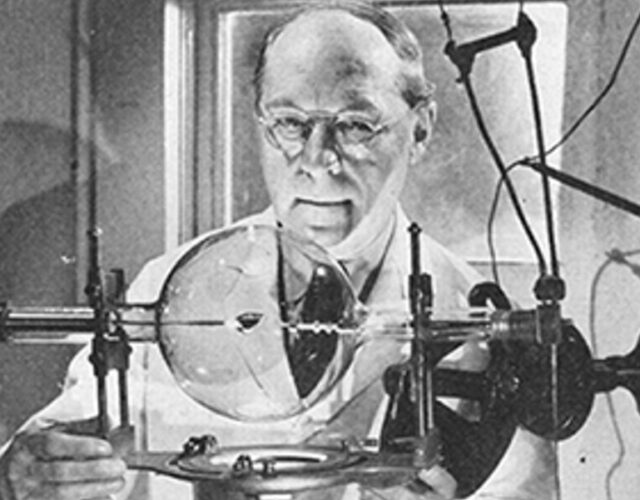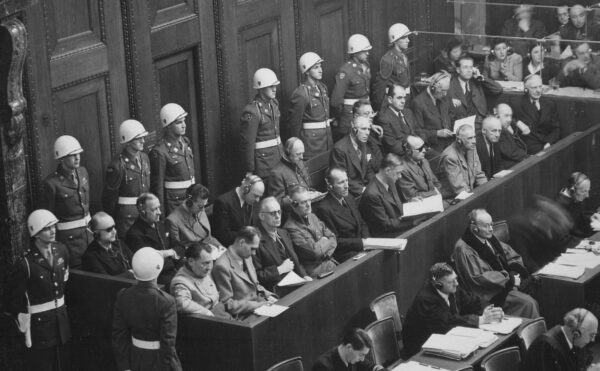In this episode of The Disappearing Spoon, Sam Kean talks about Hermann Muller, a geneticist who in the 1920s discovered that radiation causes genetic mutations. This discovery happened around the same time that other geneticists were starting to link cancer with genetic mutations. Had both of these parties communicated they would have gotten a 50-year head start in cancer research. So why didn’t scientists make this realization sooner? It turns out that Muller was a real jerk.
Credits
Host: Sam Kean
Senior Producer: Mariel Carr
Producer: Rigoberto Hernandez
Audio Engineer: Jonathan Pfeffer
Transcript
The geneticists were ready to give up. They were tramping through a forest near Austin, Texas. It was January 1932, the depths of the Great Depression. They were cold and exhausted. And with every passing step, they grew more convinced that their colleague Hermann Muller had killed himself.
It wasn’t hard to imagine why. Muller’s marriage had disintegrated. Local newspapers were denouncing him as a communist.
Still, you never expect to find a suicide note. The whole department had been scouring Austin since yesterday, hoping against hope they weren’t too late.
The crazy thing was, his colleagues didn’t even like Muller. Frankly, he was an asshole. But no one could deny he was a brilliant asshole. And the thought of a mind like his, just disappearing from the world? It made them shiver.
Finally, someone spotted something. A body. People started running, stumbling along, drawn by the shouts.
Muller was lying beneath a tree. He’d clearly been outdoors all night; his face and suit were streaked with mud. But, he was alive, if barely.
When his colleagues lifted him, he protested with slurred words—the result of all the sleeping pills he’d swallowed. But they trudged him out and got him to a hospital just in time.
Afterward, Muller tried to play the incident off like nothing had happened. He even insisted on teaching his classes the next day. He was always tough, and promised to bounce back.
But in truth, that night in the woods wasn’t even the low point for Muller. In fact, it only kicked off five more years of serial crises. Muller would soon lose his wife and a Nobel Prize, and have scary run-ins with both Adolf Hitler and Joseph Stalin.
And in retrospect, his personal suffering wasn’t even the worst of it. Muller was one of the most important geneticists ever. But his paranoia and abrasive personality led to one of the all-time missed opportunities in science. Because if he hadn’t been such an asshole, then maybe, just maybe, we’d already have a cure for cancer.
Hermann Muller was born into a Jewish family in New York City in 1890. His father died of a stroke when the boy was ten. So Muller had to take odd jobs to support his mother and sister. He ran errands for hotels and banks, and taught English to immigrants at night.
Despite the hardship, Muller excelled in school. He was handsome but short, and was determined to prove himself. He skipped two grades and co-founded the first high-school science club in the United States. He then enrolled at Columbia University at just 16 years old. It would prove the best and worst decision of his life.
Columbia was the epicenter of the new science of genetics. One lab in particular stood out—the so-called Fly Room, led by Thomas Hunt Morgan.
Readers of my book The Violinist’s Thumb will remember the Fly Room under Morgan as both revolutionary—and utterly disgusting.
Morgan studied genetics in fruit flies. He chose those flies for two reason.
First, fruit flies reproduce every two weeks—a quick turnaround that makes it easy to study how genes for traits get passed from generation to generation.
Second, Morgan studied fruit flies because they were cheap. He could feed them rotten fruit, and store them in milk bottles, which his students stole from stoops around New York. The tiny Fly Room contained hundreds of these bottles on shelves, all buzzing madly. <BUZZING>
Unfortunately, all the rotten fruit and poorly washed milk bottles meant that the Fly Room smelled awful. It didn’t help that Morgan crammed several sweaty adolescents in there as assistants. Pee-yew. Visiting scientists were amazed at how squalid the place was.
But those visiting scientists kept visiting, because Morgan’s team made several brilliant discoveries. About what genes and chromosomes were. About genetic diseases and how mutations spread. About the deep links between genetics and evolution. Much of modern biology began in the squalid Fly Room.
And Hermann Muller was right there in the thick of things. He had dozens of brilliant insights. Unfortunately, personality clashes with other lab members undermined his contributions.
Even Muller’s best friends recognized his flaws—he was insecure, tactless, heavy-handed. It didn’t help that Thomas Hunt Morgan shamelessly favored certain assistants over him. His golden boys. These golden boys got desks right next to Morgan in the Fly Room. In contrast, the cranky Muller often had work down the hall. It probably smelled better there, but the banishment provoked his jealousy.
And while Morgan paid the golden boys a salary, he refused to pay Muller anything. So Muller had to keep working odd jobs, to support his mother. His meals consisted of sandwiches scarfed down on the subway between gigs. Muller finally had a nervous breakdown and collapsed from exhaustion.
Amid all the slights he suffered, however, one thing above all enraged Muller. The fact that Morgan borrowed—or stole—his ideas.
Morgan was one of those scientists who believed that ideas were cheap. Anyone could spout off some theory. What mattered to him were experiments. Data. Proof. And while Muller did think up loads of clever experiments, he rarely got around to actually performing them—partly because he didn’t have time. But Morgan thought he was just lazy.
Today, we can see that both Muller and Morgan were half-right. Muller’s ideas were brilliant, certainly. But they were just that, just ideas, until Morgan and others proved them right.
At the same time, Morgan and company might never have run the experiments had Muller not suggested them. Science needs both things—theory and experiment.
Unfortunately, at the end of the day, Morgan was older and more powerful. As a result, he got credit for much of Muller’s work.
All of which made Muller seethe. He endured it for years. Finally, in the 1920s, he bolted to a college in Texas to start a rival lab. But if he thought he’d find some peace there, he was dead wrong.
To be sure, Muller did some brilliant work in Texas. His most important discovery involved radiation and mutations.
Before this, scientists studying mutations in flies had to sit around the lab and just wait for mutations to pop up naturally. Maybe one did per month, if they were lucky. It was slow and inefficient.
In contrast, Muller discovered a way to mass-produce mutations—by firing x-rays at fly eggs. This greatly sped up the pace of genetics. Scientists worldwide saluted him. He’d finally crawled out of Morgan’s shadow.
Unfortunately, just as his professional life soared, his personal life began unraveling. Shortly after moving to Texas, he met Jessie Jacobs, a rare female mathematician with a university job. They fell in love, got married, and had a son.
But having a child got Jacobs fired from the University of Texas. Why? Because her bosses felt that raising a child should be her first priority, and that her job would interfere. So she got the boot.
This upset Muller—and Jacobs was of course even more outraged. She felt stifled and frustrated, and the whole situation put a huge strain on their marriage.
This wasn’t Muller’s only headache, either. As a lifelong New Yorker, he felt bewildered in the Lone Star State. And his politics—which were avowedly socialist—clashed with sensibilities there. He agitated for unions, and equal pay for women and minorities. He also joined a communist front group, at which point the FBI began spying on him. Stories about the radical professor began appearing in newspapers.
Muller was also clashing with colleagues again. They badgered him to help with their research, but rarely helped with his. He felt exploited, and began brawling with them. To get any work done, he began spending nights at the lab. Which of course angered his wife, who was stuck alone with their child, and led to more fights. Muller was already going bald by then, and the stress no doubt accelerated the process.
This vicious cycle culminated in his suicide attempt in 1932. His suicide note said he was, quote, “too psychologically old to continue the struggles.” He was all of 42. He also willed $1,000 to the communist party. He didn’t mention his wife or child at all.
It was nevertheless his wife who saved him. The day Muller wandered into the woods and swallowed the sleeping pills, his wife called the genetics department, frantic, and told them he was missing. That’s when they searched his office and found the note and began looking for him. Without her, they wouldn’t have arrived in time.
After recovering, Muller was burned out and humiliated. He wanted to flee Texas. So in 1932, he accepted a fellowship at a research institute in Germany. It seemed like a fresh start.
Unfortunately, he had horrendous timing. He arrived in Germany just months before Adolf Hitler seized power. Hitler hated communists, and word got around that Muller was one. And a Jew to boot.
Inevitably, in 1933, an anti-communist riot broke out one day. Books were burned. <SMASHING> Nazi thugs smashed the windows at Muller’s institute, and spray-painted it with graffiti. Muller escaped unharmed, but feared he wouldn’t be so lucky next time.
Meanwhile, unexpectedly, more bad news arrived from America.
There, his old boss Thomas Hunt Morgan had won the Nobel Prize—based in part on work that his assistants had done. To his credit, Morgan realized this and was embarrassed. So he split the prize money with his assistants. But only with the golden boys. He cut out Hermann Muller, who didn’t get a dime.
Talk about kicking someone who was down. So with no money, and Nazi thugs running wild in Germany, Muller fled to the Soviet Union.
Once again, he was seeking a fresh start. And once again he had horrendous timing.
The U.S.S.R. was undergoing a seismic scientific convulsion then. The reasons are complex, but in short, a huge fight broke out between geneticists and Communist Party scientists.
You see, genetics then emphasized fixed traits. Traits that got passed without change from parent to child.
But Communist scientists hated that idea. They claimed that human beings had no fixed traits. Instead, they said you could remake humans to an infinite degree by changing their environment. Some communist scientists even denied that genes existed.
Now, Muller was actually a critic of genetic determinism. For instance, he criticized certain eugenicists for blaming poverty on defective genes. Poverty, he argued, often had roots in social and political issues.
At the same time, saying genes didn’t exist was crazy-bonkers. Environment is important, sure, but humans do have inborn traits. So in 1936, Muller stood up in front of three thousand Soviet scientists at a conference, and denounced the anti-genetics crew as charlatans and thugs.
It was incredibly brave—and incredibly stupid. The anti-genetics crew had the ear of the Big Guy, Joseph Stalin. And according to them, there was no middle ground here. If you weren’t completely on their side, you might as well be Hitler.
These thugs soon made genetics illegal in the Soviet Union. Two of Muller’s students were even jailed and executed—the first of many deaths to come. Hermann Muller once again found himself a marked man in a despotic country.
And once again, he barely escaped with his life. The Soviets allowed him to leave the country only when he promised to fight for the communists in the Spanish Civil War. Muller arrived in Spain in 1937, served eight weeks with a medical group, and fled.
Muller’s wife had already divorced him by that point, so he was all alone. He drifted to jobs in Edinburgh and Massachusetts. He finally landed a post at Indiana University, which recruited Jewish professors that snobby East Coast schools shunned. Muller settled there in 1945, and finally, finally won some recognition—albeit for terrible reasons.
In August 1945, World War II ended with atomic bombs over Hiroshima and Nagasaki. Those bombs exposed people to massive amounts of radiation, including high-powered x-rays called gamma rays.
Well, Muller had first discovered how x-rays affect genes—by mutating them. So suddenly, his work looked alarmingly important. As a result, he won the Nobel Prize in 1946.
Now in some ways, the Nobel Prize was the capstone of Muller’s professional life. He’d suffered a lot, but finally got the recognition he deserved. However, there is more to unpack here.
Thankfully, there have been no atomic bomb attacks since 1945. As a result, radiation damage remains rare today. But in all the hoopla about atomic bombs, scientists missed another, subtler aspect of Muller’s work—its unexpected links to cancer research.
In the 1920s, medical scientists started realizing that radiation can cause cancer. For instance, overenthusiastic dentists and other pioneers of x-ray research often died of cancer.
And around that same time, Hermann Muller demonstrated that radiation caused mutations to genes. So if radiation caused mutations, and radiation also caused cancer, could there be a link between mutations and cancer?
Yes—except no one realized it!
We don’t normally think of cancer as a genetic disease, but it is. Whether it’s breast cancer, prostate cancer, brain cancer—all cancers involve genetic mutations. These mutations allow cells to multiply out of control and destroy the body. Fundamentally, cancer is a genetic disease.
And thanks to Hermann Muller’s work on mutations, scientists had all the pieces right there in the 1920s. Some historians speculate that if Muller hadn’t alienated so many colleagues, or been so paranoid and jealous about his ideas, then perhaps he or someone else could have made the leap, and realized that genetic mutations are the root cause of cancer.
Instead, cancer research balkanized into several warring camps. Some scientists blamed cancer on chemical pollutants. Others blamed viruses or bad diets. It was a huge, incoherent mess. Today we can see the common denominator. Pollutants can cause cancer because pollutants mutate genes. Viruses can cause cancer because…viruses mutate genes. Ditto for radiation. But the world expert on mutations and radiation, Hermann Muller was too busy battling colleagues and fleeing foreign despots to work out the cancer connection.
Muller eventually died in 1967. And it wasn’t until later, the 1970s, that scientists finally, finally linked genetic mutations to cancer. Fifty wasted years.
Imagine if we could take the drugs and technologies of fifty years from now, and import them back to today. I realize how speculative this all is. But imagine how many lives would be spared. It’s even possible that we’ll have cured many types of cancer in a half-century. But that’s cold comfort to the people dying right now.
One of the beauties of science is that it’s impersonal. The humanities are not. No one except Shakespeare could have written Othello. No one except Mozart could have composed The Magic Flute. But if Isaac Newton or Albert Einstein never existed, someone else would have discovered what they did. That’s why science is impersonal—the truths are universally accessible.
But that’s not to say that personalities don’t matter in science. Yes, we eventually discovered what Hermann Muller and his feuding colleagues missed about the links between genes, mutations, and cancer. But millions suffered and died during that long gap. Science might be impersonal, but real people still feel the sting of this lost chance every day.




